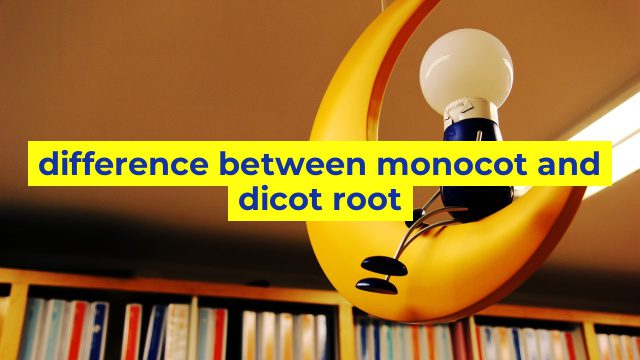The Difference Between Monocot and Dicot Roots: An Overview
When it comes to plants, roots play a critical role in anchoring the plant to the ground and absorbing water and nutrients from the soil. But not all plant roots are created equal. Botanists classify roots into two main groups based on their characteristics – monocot and dicot roots. In this article, we’ll explore the differences between these two types of roots.
Monocot Roots
Monocot roots, as the name suggests, are roots found in monocotyledonous plants. These are plants that have only one embryonic seed leaf (cotyledon) when they sprout from a seed. Examples of monocot plants include corn, rice, and grass.
Monocot roots have a few distinguishing features that set them apart from dicot roots. Firstly, monocot roots grow from the base of the stem, giving them a fibrous appearance. They are generally thin and long, with a dense network of fine lateral roots that spread out in all directions. This fibrous root system helps to anchor the plant into the soil and allows it to absorb water and nutrients efficiently.
Another characteristic of monocot roots is their lack of a central taproot. Instead of a single main root, monocot roots have numerous smaller roots that arise from the base of the stem. This root system helps monocots to thrive in areas where the soil is shallow or prone to erosion.
Dicot Roots
Dicot roots, on the other hand, are found in dicotyledonous plants, which have two embryonic seed leaves upon sprouting. Examples of dicot plants include oak trees, beans, and tomatoes.
Dicot roots have a taproot system, comprising of one main root that grows vertically downwards and gives off smaller lateral roots. This taproot system can extend deeply into the soil, allowing the plant to access water and nutrients from deeper layers of the soil than monocots. This makes them well-suited to surviving in dry or nutrient-depleted soils.
Additionally, dicot roots can also store reserves of water and nutrients in the taproot, which can be essential for the plant’s survival during periods of drought or other stress.
Conclusion
In summary, the main difference between monocot and dicot roots lies in their structure and function. While monocot roots have a fibrous appearance and lack a central taproot, they compensate for this by having a dense network of fine lateral roots that spread out in all directions. Dicot roots, on the other hand, have a taproot system that allows them to extend deep into the soil, giving them access to water and nutrients that may be out of reach for monocots.
Understanding the differences between these two types of roots is essential for farmers, gardeners, and botanists alike, as it can help with the selection of the right plants for particular soils or growing conditions.
Table difference between monocot and dicot root
| Monocot Root | Dicot Root | |
|---|---|---|
| Number of cotyledons | One | Two |
| Arrangement of vascular bundles in the stem | Scattered | Arranged in a ring |
| Primary root system | Shallow and fibrous | Deep and taproot |
| Presence of secondary growth | Usually absent | Present |
| Shape and size of root | Narrow and fibrous | Thick and fleshy |
| Location of apical meristem | At the base of the stem | At the tip of the root |
